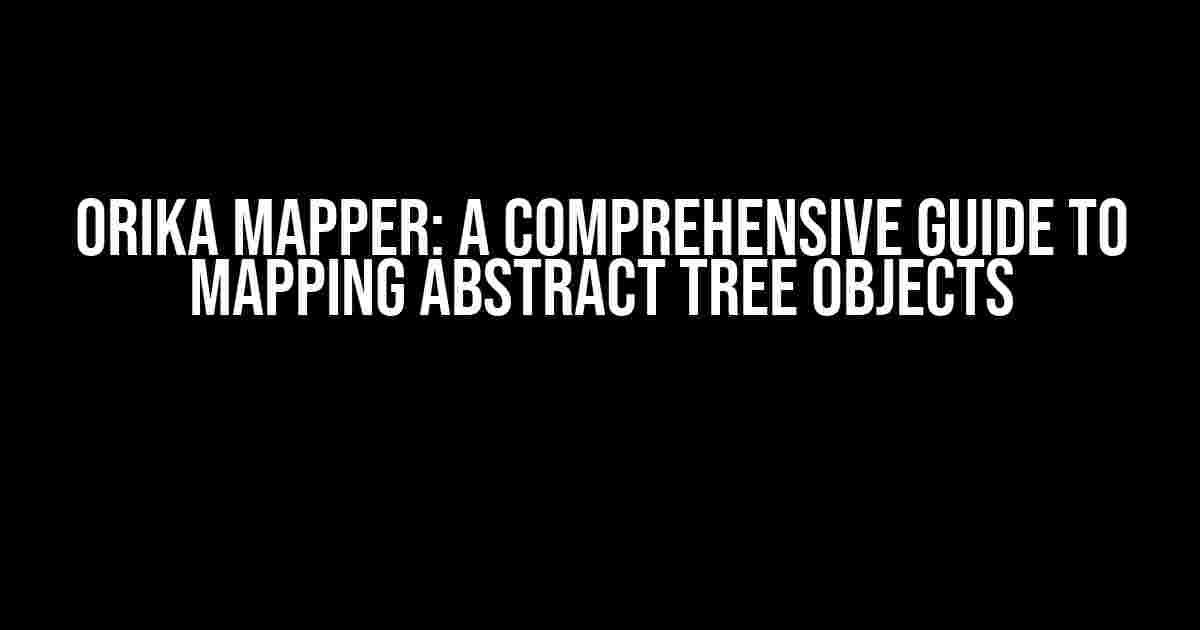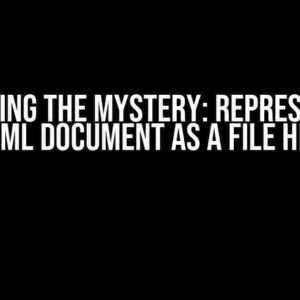Orika Mapper is a powerful tool used for mapping abstract tree objects, allowing developers to simplify their data mapping processes and improve overall efficiency. In this article, we’ll delve into the world of Orika Mapper, exploring its features, benefits, and providing step-by-step instructions on how to implement it in your projects.
What is Orika Mapper?
Orika Mapper is a Java-based library designed for mapping objects between different systems, formats, or representations. It provides a flexible and extensible framework for mapping abstract tree objects, making it an ideal solution for complex data integration and transformation tasks.
Key Features of Orika Mapper
- Flexible Mapping: Orika Mapper allows you to define custom mapping rules and formulas, giving you complete control over the mapping process.
- Abstract Tree Object Support: Orika Mapper is designed specifically for mapping abstract tree objects, making it an ideal solution for complex data structures.
- High-Performance: Orika Mapper is optimized for performance, allowing you to process large datasets quickly and efficiently.
- Extensive Customization: Orika Mapper provides a wide range of customization options, enabling you to tailor the library to your specific needs.
Setting up Orika Mapper
To get started with Orika Mapper, you’ll need to add the library to your project. Here’s a step-by-step guide:
- Add the following dependency to your
pom.xmlfile (if you’re using Maven):<dependency> <groupId>ma.glasnost.orika</groupId> <artifactId>orika-core</artifactId> <version>1.5.4</version> </dependency> - Alternatively, you can download the Orika Mapper JAR file from the official website and add it to your project’s classpath.
Basic Mapping with Orika Mapper
Now that you have Orika Mapper set up, let’s create a basic mapping example. Suppose we have two classes, SourceObject and DestinationObject, and we want to map the properties of SourceObject to DestinationObject.
public class SourceObject {
private String name;
private int age;
// Getters and setters
}
public class DestinationObject {
private String fullName;
private int ageValue;
// Getters and setters
}
To map these objects using Orika Mapper, we’ll create a MapperFactory and define the mapping rules:
MapperFactory mapperFactory = new MapperFactory.Builder().build();
Mapper<SourceObject, DestinationObject> mapper = mapperFactory.getMapper(SourceObject.class, DestinationObject.class);
mapperFactory.classMap(SourceObject.class, DestinationObject.class)
.field("name", "fullName")
.field("age", "ageValue")
.byDefault();
In this example, we’ve defined a simple mapping rule that maps the name property of SourceObject to the fullName property of DestinationObject, and the age property to the ageValue property.
Advanced Mapping Techniques
Orika Mapper provides a range of advanced mapping techniques that allow you to handle complex data structures and relationships. Here are a few examples:
Nested Object Mapping
In many cases, you’ll need to map nested object structures. Orika Mapper makes it easy to handle these scenarios:
public class SourceObject {
private Address address;
// Getters and setters
}
public class Address {
private String street;
private String city;
// Getters and setters
}
public class DestinationObject {
private AddressInfo addressInfo;
// Getters and setters
}
public class AddressInfo {
private String streetName;
private String cityValue;
// Getters and setters
}
To map the nested Address object to the AddressInfo object, you can use the following mapping rule:
mapperFactory.classMap(SourceObject.class, DestinationObject.class)
.field("address", "addressInfo")
.aBunchOf(
field("address.street", "addressInfo.streetName"),
field("address.city", "addressInfo.cityValue")
);
Collection Mapping
Orika Mapper also supports mapping of collections, including lists, sets, and maps:
public class SourceObject {
private List<String> hobbies;
// Getters and setters
}
public class DestinationObject {
private Set<String> hobbySet;
// Getters and setters
}
hobbySet set, you can use the following mapping rule:
mapperFactory.classMap(SourceObject.class, DestinationObject.class)
.field("hobbies", "hobbySet")
.use("collectionMapper")
.map("hobbies", "hobbySet", UseMapper.getInstance(CollectionMapper.class));
Best Practices for Using Orika Mapper
To get the most out of Orika Mapper, follow these best practices:
- Keep Mapping Rules Simple: Avoid complex mapping rules that can be difficult to maintain and debug.
- Use Custom Mappers: Create custom mappers to handle complex data transformations and relationships.
- Test Thoroughly: Test your mapping rules thoroughly to ensure they’re working as expected.
- Document Your Mapping Rules: Document your mapping rules to ensure that other developers can understand and maintain them.
Conclusion
Orika Mapper is a powerful tool for mapping abstract tree objects, offering a flexible and extensible framework for complex data integration and transformation tasks. By following the instructions and best practices outlined in this article, you’ll be able to harness the full potential of Orika Mapper and simplify your data mapping processes.
| Orika Mapper Feature | Description |
|---|---|
| Flexible Mapping | Customizable mapping rules and formulas |
| Abstract Tree Object Support | Designed specifically for mapping complex data structures |
| High-Performance | Optimized for processing large datasets |
| Extensive Customization | Wide range of customization options |
With Orika Mapper, you’ll be able to tackle even the most complex data mapping tasks with ease. So why wait? Start using Orika Mapper today and take your data integration and transformation to the next level!
Here are 5 Questions and Answers about “Orika Mapper map abstract tree Object”:
Frequently Asked Question
Get the answers to your questions about Orika Mapper map abstract tree Object!
What is Orika Mapper map abstract tree Object?
Orika Mapper map abstract tree Object is a powerful tool that allows you to map objects to a hierarchical structure, making it easier to navigate and manipulate complex data. It’s like having a map to treasure, but instead of treasure, it’s your data!
What are the benefits of using Orika Mapper map abstract tree Object?
The benefits are numerous! With Orika Mapper map abstract tree Object, you can simplify complex data structures, improve data integrity, and enhance data processing efficiency. It’s like having a superpower for your data!
How does Orika Mapper map abstract tree Object handle complex data relationships?
Orika Mapper map abstract tree Object uses a clever algorithm to identify and map complex data relationships, ensuring that your data is accurately represented and easily accessible. It’s like having a personal data detective on your team!
Can I use Orika Mapper map abstract tree Object with existing data systems?
Absolutely! Orika Mapper map abstract tree Object is designed to work seamlessly with a wide range of data systems, including databases, APIs, and file systems. It’s like a data chameleon, adapting to any environment!
Is Orika Mapper map abstract tree Object easy to use and integrate?
You bet! Orika Mapper map abstract tree Object is designed with ease of use in mind, providing a intuitive API and comprehensive documentation to get you started quickly. It’s like having a data sidekick, making your life easier!




